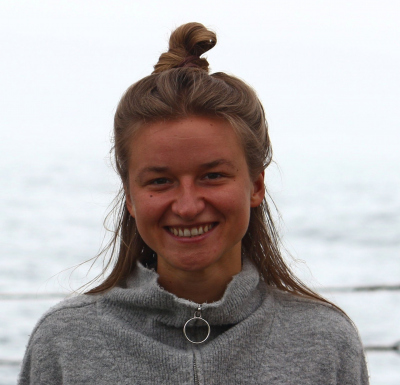- Graduate School GLOMAR
- PhD student members
- Isabel Lange
Isabel Lange
| Institution: | University of Bremen |
| Office: | GEO building, room 5190 |
| Phone: | +49 421 218 - 65136 |
| E-mail: | [Bitte aktivieren Sie Javascript] |
| Other webpage(s): | Isabel's FB 5 web page |

PhD Project
CO2-sequestration in submarine basaltic aquifers
Carbon capture and storage (CCS) strategies, such as controlled carbon sequestration in geological formations, represent a promising approach to mitigate - and even reduce - the CO2 concentration in the atmosphere, and provide safe, long-term carbon reservoirs. In this context, basaltic formations, such as the oceanic crust, gained increasing attention as potential CO2-reservoir rocks due to their large occurence, their large storage capacity and their chemical composition, which is comparatively rich in divalent cations, e.g., calcium, magnesium and iron. The injection of CO2-acidified fluids into such divalent metal-bearing host rocks has the advantage that the CO2 can be trapped as solid material, i.e., in form of carbonate minerals. However, this storage mechanism involves complex chemical reactions, which need to be better understood, especially for conditions relevant to submarine basaltic reservoirs.
My PhD project is incorporated into an interdisciplinary project (AIMS3) – a subproject of the CDRmare mission (CDR: Carbon Dioxide Removal), an initiative of the “Deutsche Allianz für Meeresforschung" (DAM) - to explore and evaluate the potential of carbon sequestration into altered, porous oceanic crust with a special focus on cold, slow-spreading mid-ocean ridge flanks (e.g. the Reykjanes Ridge). Therefore, I am investigating reactions between CO2-enriched seawater and various porous mid-ocean ridge basalt substrates. For this, I am performing batch and flow-through experiments combined with a variety of analytical techniques. One major focus of my experiments lies on the understanding of fluid flow properties and their impact on carbonate precipitation and pore space evolution. The results of my experiments aim to provide important parametrizations scaled up by numerical models to estimate the effectiveness of this CDR method on a large scale.
Thesis Committee
| Prof. Dr. Wolfgang Bach | University of Bremen, MARUM - Center for Marine Environmental Sciences, University of Bremen |
| Dr. Wolf-Achim Kahl | University of Bremen, MAPEX - Center for Materials and Processes |
| Prof. Dr. Achim Kopf | University of Bremen, MARUM - Center for Marine Environmental Sciences, University of Bremen |
| Dr. Miriam Römer | University of Bremen, MARUM - Center for Marine Environmental Sciences, University of Bremen |
| Dr. Marguerite Godard | University of Montpellier |


